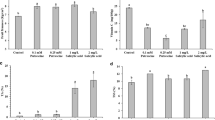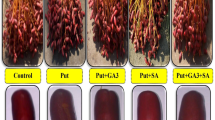Abstract
Efficiency of various growth regulators viz. gibberellic acid, salicylic acid, jasmonic acid, methyl jasmonate, putrescine, spermine and spermidine in improving the postharvest performance of cut scapes of Iris germanica L. was examined. Flower scapes harvested with the oldest bud at pencil stage (1 day before anthesis) were cut to a uniform length of 35 cm under water and divided into eight sets. Each set was provided with a different vase solution viz. gibberellic acid, salicylic acid, jasmonic acid, methyl jasmonate, putrescine, spermine and spermidine alone or in combination with 0.1 M sucrose. A separate set of scapes held in distilled water was designated as control. Application of putrescine in the vase resulted in the maximum enhancement of vase life by 6.4 days as compared to the control. All the growth regulators applied resulted in the significant increment of vase life against the control except for gibberellic acid which showed comparable vase life to control. Full blooming (100 %) was achieved in the scapes treated with putrescine and spermine alone or in combination with sucrose. Spermine treatment resulted in the burst of flowering on day 4 against the normal sequential blooming behavior of Iris species. Improved postharvest performance by the application of various growth regulators was associated with decrease in lipid peroxidase and lipoxygenase activity and an increased activity of various antioxidant enzymes like catalase, superoxide dismutase and ascorbate peroxidase besides maintaining higher values of soluble proteins, sugar fractions, total phenols and membrane stability index.









Similar content being viewed by others
References
van Doorn WG, Woltering EJ (2008) Physiology and molecular biology of petal senescence. J Exp Bot 59(3):453–480
Dar RA, Tahir I, Ahmad SS (2014) Sugars and sugar alcohol have their say in the regulation of flower senescence in Dianthus chinensis L. Sci Hortic 174:24–28
Ahmad SS, Tahir I (2015) Storage protocol for improving the postharvest performance in cut scapes of Iris versicolor. Acta Hortic 1060:71–79
van Doorn WG, Celikel FG, Pak C, Harkema H (2013) Delay of Iris flower senescence by cytokinins and jasmonates. Physiol Plant 148:105–120
Stead AD (1992) Pollination induced flower senescence—a review. Plant Growth Regul 11:13–20
Lombardi L, Arrom L, Mariotti L, Battelli R, Picciarelli P, Kille P, Stead T, Munné-Bosch S, Rogers H (2013) Auxin involvement in tepal senescence and abscission in Lilium: a tale of two lilies. J Exp Bot 66(3):945–956
Saks Y, van Staden J, Smith MT (1992) Effect of gibberellic acid on carnation flower senescence evidence that the delay of carnation flower senescence by gibberellic acid depends on the stage of flower development. Plant Growth Regul 12:105–110
Dar RA, Tahir I, Ahmad SS (2015) Is the biochemical mechanism of senescence similar within a genus? A case study of Dianthus. Hortic Environ Biotechnol 56(5):654–661
Porat R, Borochov A, Halevy AH (1993) Enhancement of petunia and dendrobium flower senescence by jasmonic acid methyl ester is via the promotion of ethylene. Plant Growth Regul 13:297–301
Kazemi M, Hadavi E, Hekmati J (2011) Role of salicylic acid in decreases of membrane senescence in cut carnation flowers. Am J Plant Physiol 6(2):106–112
Nisar S, Tahir I, Ahmad SS (2015) Modulation of flower senescence in Nicotiana plumbaginifolia L. by polyamines. Indian J Plant Physiol 20(2):186–190
Sawhney RK, Tiburcio AF, Altabella T, Galston AW (2003) Polyamines in plants: an overview. J Cell Mol Biol 2:1–12
Sairam RK (1994) Effect of moisture stress on physiological activities of two contrasting wheat genotypes. Indian J Exp Biol 32:584–593
Heath RL, Packer L (1968) Photoperoxidation in isolated chloroplast I. Kinetics and stochiometry of fatty acid peroxidation. Arch Biochem Biophys 125:189–198
Rosen H (1957) A modified ninhydrin colorimetric analysis for amino acids. Arch Biochem Biophys 67(1):10–15
Swain T, Hillis WE (1959) The phenolic constituents of Prunus domestica I. The quantitative analysis of phenolic constituents. J Sci Food Agric 10(1):63–68
Nelson N (1944) A photometric adaptation of the Somogyi method for the determination of glucose. J Biol Chem 153:375–380
Lowry OH, Rosebrough NJ, Farr AL, Randall RJ (1951) Protein measurement with the Folin phenol reagent. J Biol Chem 193(1):265–275
Tayyab S, Qamar S (1992) A look into enzyme kinetics: some introductory experiments. Biochem Educ 20(2):116–118
Dhindsa RS, Plumb-Dhindsa D, Thorpe TA (1981) Leaf senescence: correlated with increased levels of membrane permeability and lipid peroxidation, and decreased levels of superoxide dismutase and catalase. J Exp Bot 32:93–101
Aebi H (1984) Catalase in vitro. Methods Enzymol 105:121–126
Chen GX, Asada K (1989) Ascorbate peroxidase in tea leaves: occurrence of two isozymes and the differences in their enzymatic and molecular properties. Plant Cell Physiol 30:987–998
Axerold B, Chesbrough TM, Laakso S (1981) Lipoxygenase from soybean. In: Lowenstein JM (ed) Methods enzymology. Academic press, New York, pp 441–451
Pak C, van Doorn WG (2005) Delay of Iris flower senescence by protease inhibitors. New Phytol 165:473–480
Rubinstein B (2000) Regulation of cell death in flower petals. Plant Mol Biol 44(3):303–318
Fukuchi-Mizutani M, Ishiguro K, Nakayama T, Utsunomiya Y, Tanaka Y, Kusumi T, Ueda T (2000) Molecular and functional characterization of a rose lipoxygenase cDNA related to flower senescence. Plant Sci 160:129–137
Saeed T, Hassan I, Abbasi NA, Jilani G (2014) Effect of gibberellic acid on the vase life and oxidative activities in senescing cut gladiolus flowers. Plant Growth Regul 72:89–95
Mwangi M, Chatterjee SR, Bhattacharjee SK (2003) Changes in the biochemical constituents of “Golden gate” cut rose petals as affected by precooling with ice cold water spray, pulsing and packaging. J Plant Biol 30:95–97
Schmitzer V, Veberic R, Osterc G, Stampar F (2010) Color and phenolic content changes during flower development in groundcover rose. J Am Soc Hortic Sci 135(3):195–202
Lattanzio M, Lattanzio VMT, Cardinali A (2006) Role of phenolics in the resistance mechanisms of plants against fungal pathogens and insects. In: Imperato F (ed) Phytochemistry: advances in research. Research Signpost, Kerala, India, pp 23–67
Dar RA, Tahir I, Ahmad SS (2014) Physiological and biochemical changes associated with flower development and senescence in Dianthus chinensis. Indian J Plant Physiol 19:215–221
Galston AW, Sawhney KR (1990) Polyamines in plant physiology. Plant Physiol 94:406–410
van Doorn WG (2004) Is petal senescence due to sugar starvation? Plant Physiol 134:35–42
Ahmad SS, Tahir I, Shahri W (2013) Effect of different storage treatments on physiology and postharvest performance in cut scapes of three Iris species. J Agric Sci Technol 15:323–331
Cakmak T, Otici O (2009) Effects of putrescine and low temperature on the apoplastic antioxidant enzymes in the leaves of two wheat cultivars. Plant Soil Environ 55(8):320–326
Schopfer P, Plachy C, Frahry G (2001) Release of reactive oxygen intermediates (superoxide radicals, hydrogen peroxides and hydroxyl radicals) and peroxidase in germinating radish seeds controlled by light, gibberellin and abscisic acid. Plant Physiol 125:1591–1602
Acknowledgments
Syed Sabhi Ahmad thanks University Grants Commission (UGC), Govt. of India for providing SRF under (UGC-BSR) scheme.
Author information
Authors and Affiliations
Corresponding author
Ethics declarations
Conflict of interest
The authors have no conflict of interest.
Rights and permissions
About this article
Cite this article
Ahmad, S.S., Tahir, I. Putrescine and Jasmonates Outplay Conventional Growth Regulators in Improving Postharvest Performance of Iris germanica L. Cut Scapes. Proc. Natl. Acad. Sci., India, Sect. B Biol. Sci. 88, 391–402 (2018). https://doi.org/10.1007/s40011-016-0767-2
Received:
Revised:
Accepted:
Published:
Issue Date:
DOI: https://doi.org/10.1007/s40011-016-0767-2




